I am trying to implement a custom drag and drop directive. It works, but it is extremely slow, and I think the slowness can be tracked to Angular 2 because I've never encountered this slowness before. The slowness only occurs when I attach an event listener to the dragover or drag events (i.e. the events which are sent frequently), even if I do nothing but return false in them.
Here's my directive code:
import {Directive, ElementRef, Inject, Injectable} from 'angular2/core';
declare var jQuery: any;
declare var document: any;
@Directive({
selector: '.my-log',
host: {
'(dragstart)': 'onDragStart($event)',
'(dragover)': 'onDragOver($event)',
'(dragleave)': 'onDragLeave($event)',
'(dragenter)': 'onDragEnter($event)',
'(drop)': 'onDrop($event)',
}
})
@Injectable()
export class DraggableDirective {
refcount = 0;
jel;
constructor( @Inject(ElementRef) private el: ElementRef) {
el.nativeElement.setAttribute('draggable', 'true');
this.jel = jQuery(el.nativeElement);
}
onDragStart(ev) {
ev.dataTransfer.setData('Text', ev.target.id);
}
onDragOver(ev) {
return false;
}
onDragEnter(ev) {
if (this.refcount === 0) {
this.jel.addClass('my-dragging-over');
}
this.refcount++;
}
onDragLeave(ev) {
this.refcount--;
if (this.refcount === 0) {
this.jel.removeClass('my-dragging-over');
}
}
onDrop(ev) {
this.jel.removeClass('my-dragging-over');
this.refcount = 0;
}
}
Here's the relevant style sheet excerpt:
.my-log.my-dragging-over {
background-color: yellow;
}
As you can see all I'm doing is highlighting the element being dragged over in yellow. And it works fast when I don't handle the dragover event, however I must handle it to support dropping. When I do handle the dragover event, everything slows down to unbearable levels!!
EDIT I am using angular beta 2.0.0-beta.8
EDIT #2 I tried profiling the code using chrome's profiler, these are the results:

Look at the marked line, it is strangely suspicious...
EDIT #3 Found the problem: it was indeed due to Angular 2's change detection. The drag and drop operation in my case is done on a very dense page with a lot of bindings and directives. When I commented out everything except the given list, it worked fast again... Now I need your help in finding a solution to this!